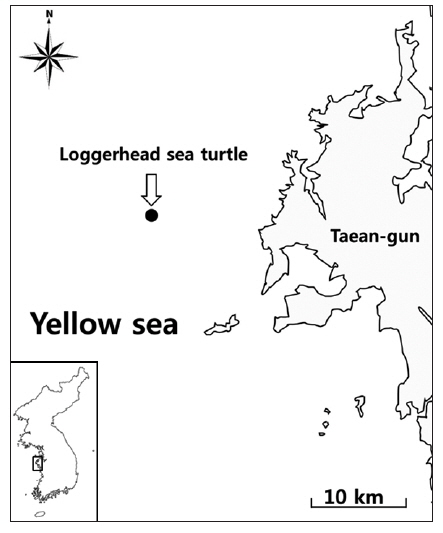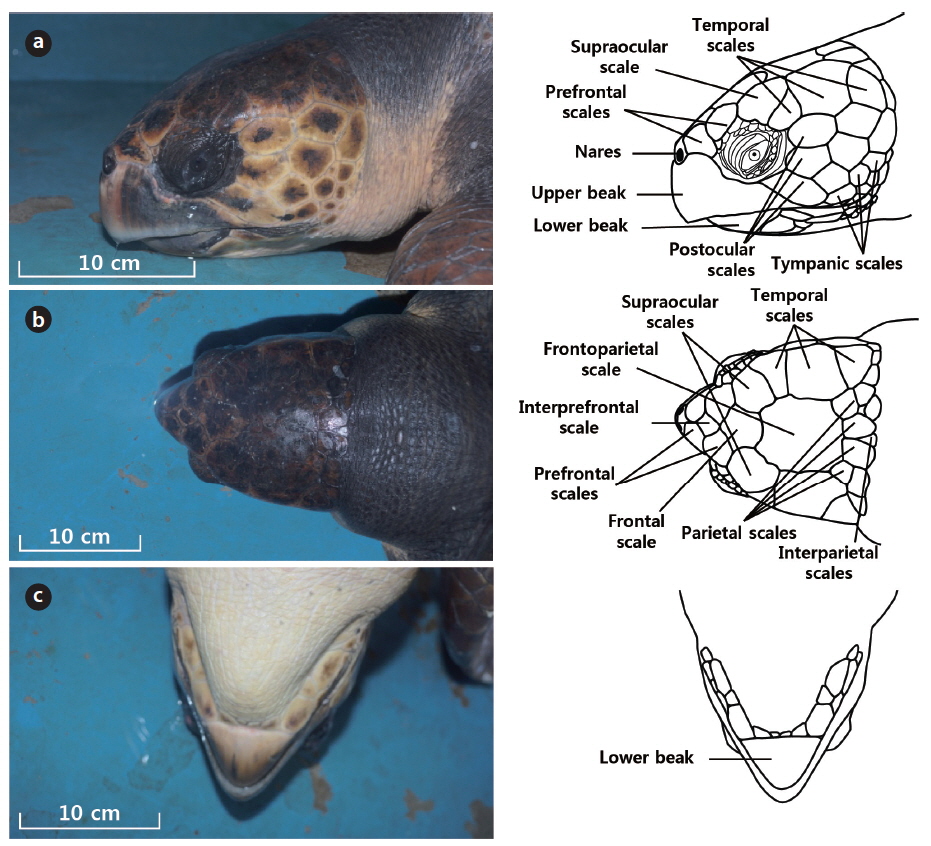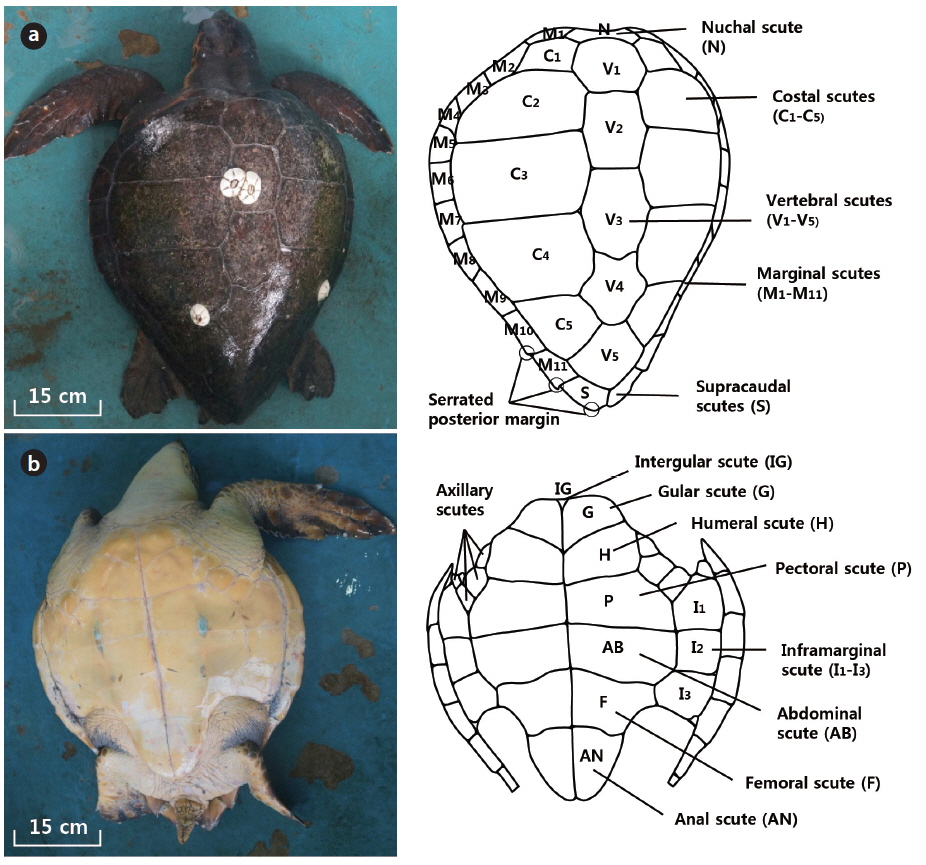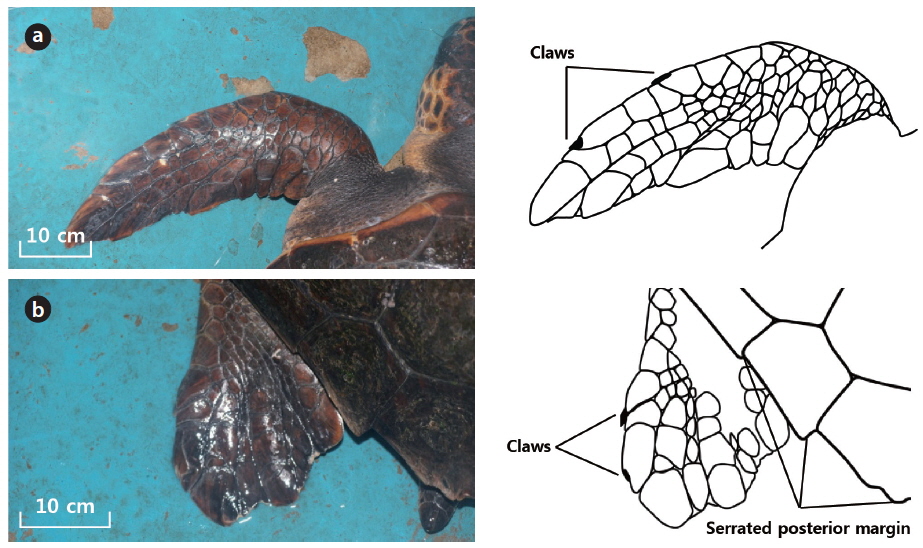



To date, no study has reported detailed morphological characteristics of Korean sea turtles. Due to the lack of such basic information on Korean sea turtles, further related studies have been difficult in South Korea. In this report, we determined the species and the sex of the one sea turtle caught from the Yellow Sea of Korea (Taean-gun, Chungcheongnamdo) on July 17, 2013, and described its detailed morphological characteristics. The sea turtle was identified as a loggerhead sea turtle (Caretta caretta) by the presence of an interprefrontal scale on the head. The turtle had three times longer length between the edge of anal scute to the anus than that between the anus to tip of the tail, and the size of a pair of claws on the flippers were distinctively different, suggesting that the turtle was a male. Finally, the assumption that the sea turtle might be sexually mature is based on its body weight (59.95 kg), the maximum straight length of the carapace (72.5 cm), and the worn serrated parts at the edge of supracaudal scutes. The loggerhead sea turtle described in this study is the first record from the Yellow Sea of Korea.
Globally, seven species in six genus in two families of sea turtles, which are one of representative marine reptiles, have been recorded and they are widely distributed from the Arctic Ocean (70 degrees north latitude) to the Tasman Sea (45 degrees south latitude) (Marquez 1990, Klemens 2000, IUCN 2013). During the breeding season, they are mainly found at tropical or subtropical seas (Marquez 1990).
In Korean seas, loggerhead sea turtle (
Because of their low hatching success and overhunting and habitat destruction by human beings, all seven sea turtle species listed up to date (loggerhead sea turtle, green sea turtle, leatherback sea turtle, hawksbill sea turtle, Kemp’s ridley turtle
In Korea, sea turtles are being protected by the Conservation and Management of Korean Marine Ecosystem Act 11690 since 2007. Between 1930s and 1970s, several researchers summarized the list of Korean sea turtles (Hironobu 1936a, Shannon 1956, Kang and Yoon 1975). Recently, a group of researchers determined how many sea turtle species were observed at Korean seas, and, as the results, they proposed several ways to protect them (Moon et al. 2009, 2011, Jo and Hykle 2012, Jung et al. 2012a, 2012b). Nevertheless, to date, only few morphological data are available for the leatherback (Hironobu 1936a) and green sea turtle (Hironobu 1936b) that were described in Japanese in early 1930s. Therefore, many more detailed descriptions of the morphological characteristics of Korean sea turtles are still greatly necessary. Lack of such basic information has been largely holding us back from further sea turtle studies in South Korea. In this report, we classified the species and determined the sex and we described detailed morphological characteristics of one sea turtle which was caught from the Yellow Sea of Korea (Taean-gun, Chungcheongnam-do) in 2013.
On July 17, 2013, one sea turtle was accidently caught by a discarded fishing net at the vicinity of a sunken rock (36°46′22.00″ N, 125°58′55.00″ E) in Yellow Sea of Korea, rescued by a fishing boat (Ojangmi-ho, 7.93 t), transported to the near Mohang port (Mohang-ri, Sowon-myeon, Taean-gun, Chungcheongnam-do, South Korea) for checking its health condition (Fig. 1) and kept in an aquarium for a day within the Mohang maritime police station.
On July 18, 2013, we visited the station and examine the turtle. We first determined the species and sex of the turtle and visually investigated morphological characteristics. Then, we measured physical lengths according to Eckert et al. (1999) using a tapeline to the nearest 0.1 cm and the body weight using an electronic scale (DW-150; CAS, Seoul, Korea) to the nearest 0.01 kg. For some length measurements, we took photographs while placing a flexible tapeline nearby and then analyzed the lengths using Image J software, ver. 1.47 (National Institutes of Health, Bethesda, ML, USA) in the laboratory.
On the station, we recorded eight length measurements: the maximum straight plastron length (from the tip of right gular scute to the tip of right anal scute), the maximum straight plastron width (from the outermost line of left inframarginal scute to the outermost line of right inframarginal scute), head length (from the tip of the nares to the end of head scales), head width (a distance between the outer margins of the left and right eye), the minimum curved carapace length (from the anterior point at the nuchal scute to the posterior notch at midline between the supracaudal scutes), the curved carapace length notch to tip (from the anterior point at the nuchal scute to the tip of right supracaudal scute), the maximum curved carapace length (from the tip of right cephalad marginal scute to the tip of right supracaudal scute), and carapace width (from the outermost line of left marginal scute to the outermost line of right marginal scute). In the laboratory, we measured the maximum straight carapace length (from the tip of right gular scute to the tip of right anal scute), the straight carapace length notch to tip (from the anterior point at the nuchal scute to the tip of right supracaudal scute), the minimum straight carapace length (from the anterior point at the nuchal scute to the posterior notch at midline between the supracaudal scutes), the length of each claws on the both left front flipper and rear one, and the two tail-related lengths (from the tip of the anal scute to the anus and from the tip of the tail to the anus) (Eckert et al. 1999).
After investigation of physical characteristics, the health condition of the sea turtle was checked by a veterinarian. Since the condition was confirmed to be good based on its scute conditions, activity levels, and body balancing during movements, the turtle was released at the same point where it was caught on July 18, 2013.
We classified the sea turtle as a loggerhead sea turtle (
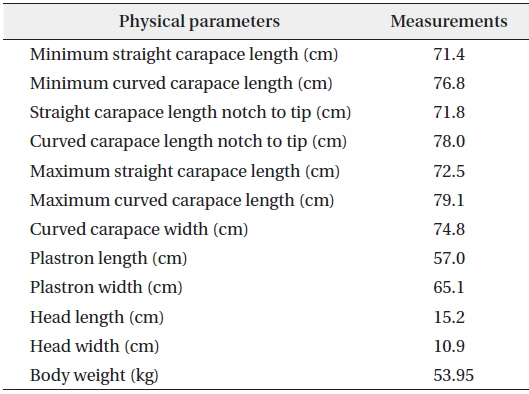
Physical characteristics of the Loggerhead turtle (Caretta caretta) caught from the Yellow Sea of Korea in 2013
In lateral and dorsal views, the head was roughly triangular-shaped (Fig. 2a and 2b). The color of the beak was light gray. The upper beak was larger than lower one (Fig. 2a). Sometimes, the beaks are termed as the rhamphotheci (Lutz et al. 2002). The nares were located at between the upper beak and the prefrontal scales. The color of the cheek was bright yellow. The color of the top of the head was dark brown. There were various head scales on the top of the head, and particularly, there was an interprefrontal scale surrounded by four prefrontal scales (Fig. 2b). The lower beak was triangular-shaped and there were some scales along the margin of low jaws and the beak (Fig. 2c).
The carapace was dark brown in color, its shape was an oval, the posterior part of the carapace was lightly tapered, and the surface was rough (Fig. 3a). There were one nuchal scute and five vertebral scutes along the midline of the body (Fig. 3a). The fifth vertebral scute distinctively protruded. At each side of the vertebral scutes, there were five costal scutes. At each side edge of the carapace, there were 11 marginal scutes adjoining anteriorly with the nuchal scute and posteriorly with a supracaudal scute (Fig. 3a). The edges of the tenth to eleventh marginal scutes and the supracaudal scute were serrated and the tips were worn (Fig. 3a).
Four barnacles were found on the carapace (Fig. 3a). Two barnacles were on the second vertebral scute; one was on the border of the fourth and fifth left costal scutes; and the last one was on the border of the fourth right costal and both eighth and ninth marginal scutes (Fig. 3a). The barnacles were not classified in this study.
The color of the plastron was light yellow (Fig. 3b). An intergular scute was located between a pair of gular scutes. The plastron consisted of each a pair of humeral scutes, pectoral scutes, abdominal scutes, femoral scutes, and anal scutes (Fig. 3b). Three inframarginal scutes at each side were located between plastron scutes and carapace marginal scutes. The first inframarginal scute adjoined with the pectoral scute; the second, with the abdominal scute; and the third, with both the abdominal and femoral scutes (Fig. 3b).
The color of the four flippers was dark brown (Fig. 4a and 4b). The front flippers were longer than rear those (Fig. 4a and 4b). A pair of claws that had different length was on each flipper. The length of the first claw was 1.33 cm and 1.07 cm and that of the smaller claw was 0.81 cm and 0.71 cm for each left front and rear flipper, respectively (Fig. 4), meaning that the first claw that was closer to the tip of the flipper was shorter than the other one. Dorsal side of the tail was brown, while the ventral part of the tail was light yellow in color.
The sea turtle described in this study was classified as a loggerhead sea turtle. The loggerhead sea turtle has several distinctive diagnostic features such as presence of an interprefrontal scale, two pairs of prefrontal scales, five vertebral scutes, five pair of costal scutes, three pair of inframarginal scutes, and a pair of claws on flippers (Marquez 1990, Eckert et al. 1999, Lutz et al. 2002, Shi et al. 2013). Particularly, among the characteristic features, the interprefrontal scale is only confirmed on the head of the loggerhead sea turtle (Marquez 1990, Eckert et al. 1999). The sea turtle described in this study had an interprefrontal scale, showing that the turtle was a loggerhead sea lesturtle. In Korean seas, the green sea turtle, leatherback sea turtle and hawksbill sea turtle have been recorded in addition to the loggerhead sea turtle (Kang and Yoon 1975, Kim and Han 2009, Moon et al. 2009). The former three sea turtle species have no interprefrontal scale so that we could easily discriminate the loggerhead sea turtle from the others. In addition, distinctively the green sea turtle has only a pair of prefrontal scales, the hawksbill sea turtle has four pairs of costal and inframarginal scutes, and the leatherback sea turtle has seven longitudinal keels on the carapace, but no scutes and scales on the head (Marquez 1990, Eckert et al. 1999). Any of these characteristics did not correspond to the characteristics of the sea turtle investigated in this study. Therefore, these distinctive features clearly showed that the sea turtle caught from the Yellow Sea of Korea was a loggerhead sea turtle.
The sex of the loggerhead sea turtle used in this study was determined as a male. Marquez (1990) reported that male loggerhead sea turtles had a pair of claws of which size were quite different, while the size of a pair of claws in females was nearly equal on all four flipper limbs. The loggerhead sea turtle used in this study had a pair of claws of which length were quite different. The first claw which was closer to the tip of the flipper was shorter than the other one. It is also known that the length from the edge of anal scutes to the anus (scute-anus length) is distinctively longer than the length from the anus to the tip of the tail (anus-tail length) in male loggerhead sea turtles, whereas the two lengths are similar in females (Marquez 1990, Eckert et al. 1999). The loggerhead sea turtle used in this study had approximately three times longer scuteanus length than the anus-tail length. These both results strongly suggested that the loggerhead sea turtle used in this study was a male although we did not anatomically confirm the sex.
In general, sexual maturation of male loggerhead sea turtles takes approximately 25-30 years and at that time, the maximum curved carapace length reaches between 75 and 92 cm (Zug et al. 1986, Casale et al. 2011). The maximum straight carapace length of the loggerhead sea turtle used in this study was 79.1 cm, suggesting that the turtle could be sexually matured. In addition, worn edges of the serrated marginal and supracaudal scutes also imply that the turtle was sexually matured. In usual, only sexually immature loggerhead sea turtles have sharp serrated edges on the scutes (Eckert et al. 1999).
The loggerhead sea turtle used in this study seemed to be caught during foraging activity. Loggerhead sea turtles are widely distributed in tropical and subtropical oceans and they generally migrate over several thousand kilometers for feeding, nesting, and breeding (Marquez 1990, Conant et al. 2009, Abecassis et al. 2013). Major nesting sites of the loggerhead sea turtle are located at the Atlantic Ocean, Indian Ocean, and western Pacific Ocean. In special, the Ryukyu Archipelago in Japan is well known as one of the most important nesting sites of the loggerhead sea turtle (Kikukawa et al. 1999). After breeding at Ryukyu Archipelago, fully grown and newly hatched loggerhead sea turtles are migrating to the Pacific Ocean where they forage floating items as preys, while sexually matured but still rapidly growing sea turtles are tending to stay at near and around Japan where they mainly forage benthic items in relatively shallow seas (JFRCA 1999, Polovina et al. 2000, Hatase et al. 2002, Abecassis et al. 2013). Therefore, the loggerhead sea turtle investigated in this study might be sexually matured, but still at growing stages and might be caught during foraging benthic items in the shallow Yellow Sea, of which average depth is approximately 45 m.
In Korea, most sea turtles have been recorded from the East Sea, South Sea or sea around Jeju Island. Since only leatherback sea turtles have been recorded up to date at the Yellow Sea of Korea (Kim and Han 2009, Moon et al. 2009), the loggerhead sea turtle described in this study is the first record from the Yellow Sea of Korea.


